The cable machine workout is perhaps the most versatile and user-friendly way to train your ab and oblique muscles in the gym.
Unlike bodyweight abdominal exercises, cable ab workouts provide consistent time under tension. This means greater core muscle activation and better results for both development and strength.
Cables also allow a wide range of motion and enable you to hit your core from multiple angles and directions, giving your core a complete workout.
It’s a great way to progressively overload and add variety to your core training by increasing the weight stack and changing the pulley positions.
Let’s discuss some of the best (based on science and experience) cable abs workouts to build a stronger core.
Try Our Free Calculator To Know Your Body Fat Percentage
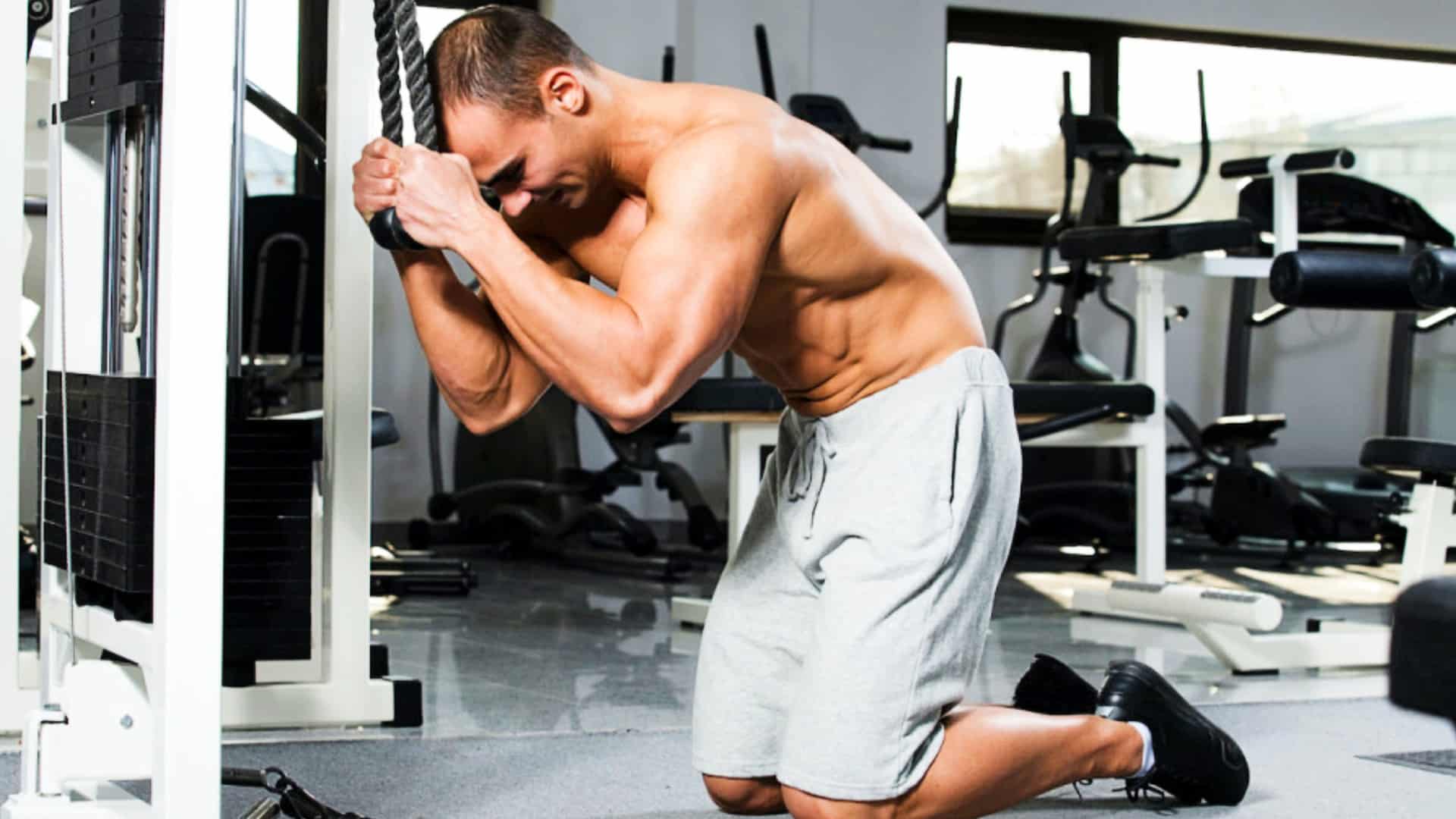
- 15 Best Cable Exercises for Ab and Oblique
- 1. Kneeling Cable Crunch
- 2. Cable Side Bend
- 3. Pallof Press
- 4. Cable Twist
- 5. Cable wood chop
- 6. Cable Down-Up Twist (Low to High Wood chop)
- 7. Standing Cable Crunch
- 8. Standing Oblique Crunch
- 9. Cable Reverse Crunch
- 10. Cable Seated Twist On The Floor
- 11. Cable Russian Twist
- 12. Cable Twisting Standing Row
- 13. Cable Twisting Overhead Press
- 14. Seated Cable Crunch
- 15. Cable side crunch on Bosu ball
- Abs and Oblique Cable Workout Routines
- Cable Abs Workout Plan
- Cable Oblique Workout Plan
- Cable Core Workout Plan
- FAQ
- Are cable machines good for abs?
- What cable Workout Is Best For Abs?
- How do you lose belly fat on a cable machine?
- Do cable Abs Workouts Slim Your Waist?
- Takeaways
- 10 Best Abs and Oblique Exercises With Cable Machine
15 Best Cable Exercises for Ab and Oblique
Below is a collection of the best ab exercises for cable machines. These exercises target your core from all angles and offer a range of twisting, kneeling, and standing movements.
1. Kneeling Cable Crunch
There is nothing inherently wrong with doing a weighted crunch, but holding a weight plate on your chest or behind your head can be uncomfortable and cumbersome. As you get stronger, it will be harder to add more weight without hurting your rib cage or straining your neck.
Here’s why it’s time to switch to the cable kneeling crunch. A machine with a pulley lets you add weight with a pin, and the constant tension of the cable makes your abs work hard every time you do the exercise.
This increased emphasis on strength and hypertrophy is accurately the kind of workout the fast-twitch muscle fibers in your abs need to get big and carved.
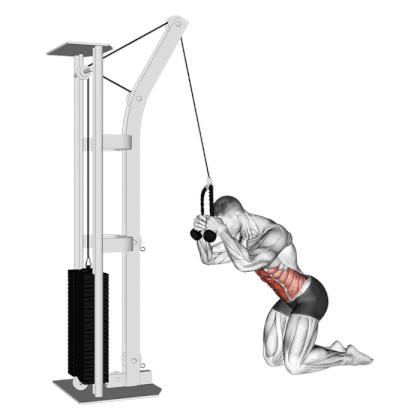
How To Do
- Take a position next to a machine equipped with a pulley with a rope attached to it.
- Kneel in front of a high pulley. Grasp the rope attachment in each hand and place your wrists against the sides of your head.
- Get on your knees and, facing the device, lock the rope handles against your ears. Keep your neck in a neutral position.
- Your torso is firm and slightly tilted forward. This is the starting position.
- Begin the movement by contracting your abs and exhaling as you bend down.
- At the point of maximum contraction, squeeze your abs tightly before slowly returning to the starting position. Inhale during this phase of the movement.
- Do not let the weight stack drop back to the starting position before the end of the set.
2. Cable Side Bend
The cable side bend is one of the best cable oblique exercises for strengthening the core muscle and targeting the obliques. This exercise also improves stability in the lower back and hips.
The cable side bend is simply a variation of the side bend typically performed using dumbbells. Using cables allows you to change the point where the load is maximized.
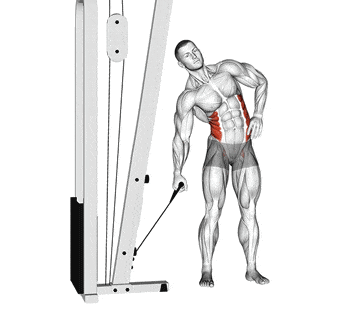
How To Do
- Attach the D-handle to a low pulley and stand side-on to the weight stack.
- Grasp the D-handle with your right hand and stand with the pulley to your right side.
- Your torso should be laterally flexed (bent sideways) towards the pulley, and your arm should be straight and close to your body.
- Bend your torso away from the pulley, pulling the D-handle upward.
- Slowly lower the D-handle back to the starting position by bending your torso towards the pulley.
- Repeat for the desired number of repetitions. Turn around and repeat the cable side bend with your left side.
3. Pallof Press
The Pallof Press may not look like the most intense exercise in the gym, but don’t let its simplicity fool you. It is more than just a core exercise—it’s a full-body challenge that demands stability from your legs, glutes, shoulders, and back.
Unlike traditional core exercises like sit-ups or planks, the Pallof Press targets your body’s ability to resist rotation.
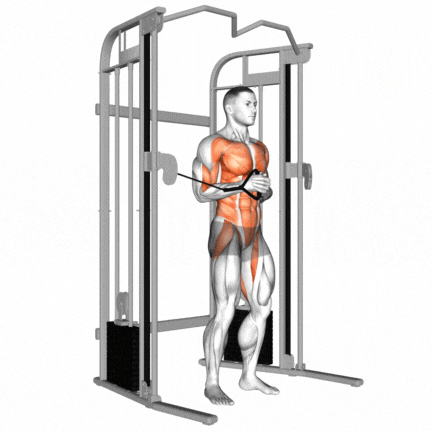
How To Do
- Attach a handle to a chest-high cable pulley. Stand on the side cable machine with your feet hip-width apart.
- Grasp the handle with the hand nearest the pulley, pull the handle to your chest, and place your free hand over the hand holding the handle.
- Engage your core and press the handle out with both hands so your arms are extended in front of your chest.
- Hold this position, resisting the pull of the cable and not letting your torso rotate towards the machine, for five to ten seconds then bring the handle back in to your chest.
- Repeat the exercise on your opposite side.
4. Cable Twist
The Cable Twist is specifically designed to build rotational strength. When you pull the cable across your body, you workout your obliques, rectus abdominis, and lower back muscles.
One of the greatest benefits of the cable twist is its ability to target deep core muscles, including the transverse abdominis and multifidus.
One thing I love about this exercise is how easily you can adjust it.
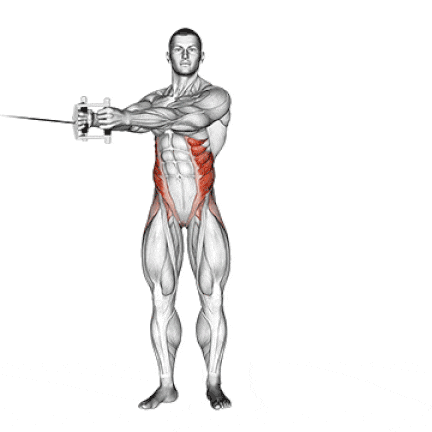
How To Do
- Attach a handle to a shoulder-height cable pulley. Grasp the handle with both hands, either with your fingers interlaced or with one hand over the other.
- Stand next to the machine with your feet shoulder-width apart.
- Keep your arms straight and pull the handle in a twisting motion across your body to your opposite side until your torso faces away from the pulley.
- Hold for a count of two. Then, slowly reverse the movement to return to the starting position.
- Repeat for the prescribed number of repetitions. Repeat the exercise on your opposite side.
Related Post: 10 Best Exercises To Lose Weight Fast At Home
5. Cable wood chop
The cable wood chop, also known as the cable up-down twist, is a multi-joint exercise that mimics the motion of chopping wood.
This is great for strengthening the twisting movement pattern of your torso and improving its ability to resist twisting forces.
You must do cable wood chop to strengthen your core muscles, including your lower back, abs, obliques, and hip muscles.
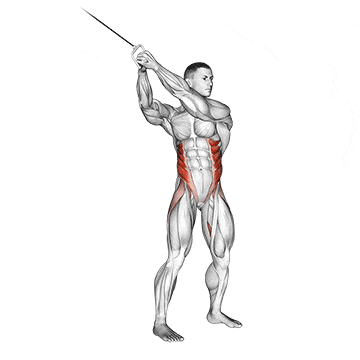
How To Do
- Attach a handle to the top of the cable pulley. Grasp the handle with both hands, with either your fingers interlaced or with one hand over the other. Stand next to the machine with your feet shoulder-width apart.
- Keeping your arms straight, pull the handle diagonally downward until your torso faces away from the pulley and your hands are knee-height.
- Hold for a count of two. Then, slowly reverse the movement to return to the starting position.
- Repeat for the prescribed number of repetitions. Repeat the exercise on your opposite side.
6. Cable Down-Up Twist (Low to High Wood chop)
First, this isn’t just an upper-body or core move—it’s a full-body workout. From your legs to your shoulders, everything gets in on the action. It’s like a one-stop shop for total body engagement.
Use the cable down-up twist to strengthen and stabilize your core and strengthen your torso’s rotational movement pattern.

How To Do
- Attach a handle to the lowest of the cable pulley. Grasp the handle with both hands, either with your fingers interlaced or with one hand over the other.
- Keeping your arms straight, pull the handle in a diagonally upward motion.
- Don’t lock the knees and hips. Allow the hips and knees to rotate slightly.
- Hold for a count of two. Then, slowly reverse the movement to return to the starting position.
- Repeat for the prescribed number of repetitions. Repeat the exercise on your opposite side.
7. Standing Cable Crunch
Unlike traditional crunches, which are limited by gravity, the cable allows you to extend through your spine and then crunch down hard. I promise you’ll feel every inch of that movement.
Because you are standing and have less stability, the standing version is the harder of the two cable crunches.
It strengthens your ab muscles as well as your lower back. The result? Better posture and less back pain. Win-win!

How To Do
- Attach a rope to a high pulley and select an appropriate weight.
- Hold one side of the rope attachment in each hand and stand with your back to the machine.
- Place the rope behind your head with your elbows tucked in and hands by your ears. Keep your neck in a neutral position.
- Keep your hips fixed. All of the movement should be in your abdomen.
- Engage your core and pull downwards into a crunch, sending your elbows toward your thighs.
- Hold the peak contraction for a moment before returning to the starting position.
8. Standing Oblique Crunch
When doing an abs workout with a cable machine, you can add plenty of single-arm exercises to correct potential imbalances.
Standing oblique crunches, also popular as side crunches, are effective abdominal exercises that target your oblique muscles performed by assuming a standing position. You can easily incorporate these exercises into your cable workout routine.
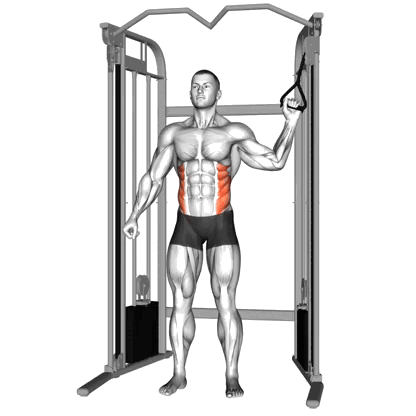
How To Do
- Attached D-handle to a high pulley and stand side-on to the weight stack.
- Grasp the D-handle with your left hand and stand with the pulley to your left side.
- Make sure your forearm is positioned at an angle of 90-degrees to the upper arm and your feet firmly placed on the floor at shoulder width.
- Keep your head up and back straight, and pull the weight down using your left oblique muscle as much as possible.
- Pause for a second and then return to the initial position.
- Repeat for the desired number of repetitions. Turn around and repeat the cable side bend with your left side.
9. Cable Reverse Crunch
The reverse crunch is a highly effective exercise that targets the entire abdominal wall, particularly the lower abs.
You do this by moving your lower body towards your upper body, engaging the lower section of the abs through a posterior pelvic tilt.
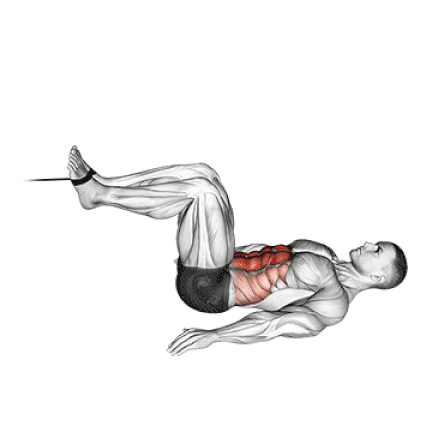
How To Do
- Connect an ankle strap to the bottom of the cable machine.
- Lie face up on the floor with your hands extended at your sides.
- Slowly bring your knees toward your chest, lifting your hips and glutes off the floor.
- Try to maintain the bend in your knees throughout the movement.
- Slowly lower your legs back to the starting position under control motion.
10. Cable Seated Twist On The Floor
The cable seated twist is excellent for building core strength. As you twist your torso against the resistance of the cable, your obliques and abdominal muscles are activated.
While your core is the star of the show, don’t be surprised if you feel it in your shoulders, arms, and upper back. It’s like that: giving you a bit more upper body work as a bonus.
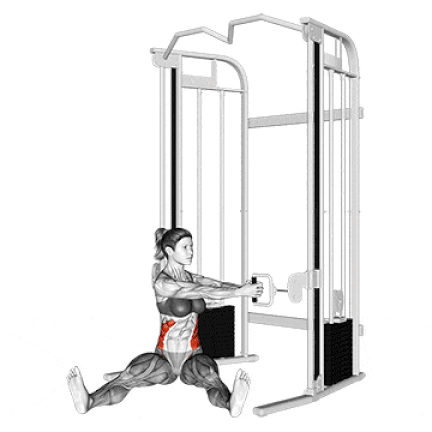
How To Do
- Set the pulley to seated shoulder height. Place your feet flat on the floor.
- Twist your torso and grasp the stirrup with both hands.
- Straighten your torso and arms. Your arms should parallel the floor and the cable should be pulled taut.
- Keep your torso and arms straight, and slowly rotate your torso to the opposite side.
- Hold for two seconds and then reverse the motion to return to the initial position.
- Make sure to get a full range of motion, twisting from one side to the other side and then back again.
11. Cable Russian Twist
Russian pulley twists on a Swiss ball are a unique exercise that you won’t see performed often in your gym. You may never have even done it yourself. However, it does have its benefits and is a great variation for working in obliques.
And since it is a functional exercise, it will help you perform better in any sporting activity. It is the best core exercise that also helps to improve your balance, stability, and posture.
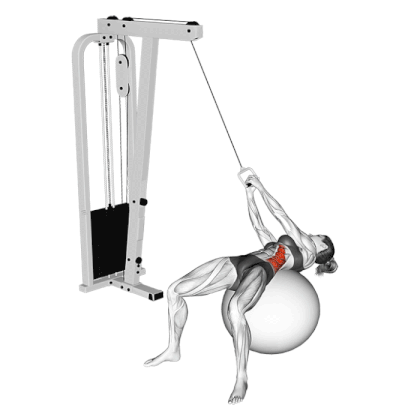
How To Do
- Attach a single-grip handle to the cable pulley high enough to fully extend your arms, and the pulley should be in line with your fists or higher.
- Place the ball next to the pulley and lie on it to where your chest is in line with the pulley.
- Grip the handle with the closest hand, and extend your arm directly over your chest, then place your other hand on top to get a firm grip.
- Keep your hips high, tighten your midsection, and rotate away from the machine using your core muscles.
- Your arms should remain straight and extended in the same position throughout the exercise. You’re only using your core to rotate your body.
- Slowly return to the starting position, resisting the weight from pulling you back too quickly.
12. Cable Twisting Standing Row
The Cable Twisting Standing Row integrates the entire kinetic chain. It begins with ground reaction forces through the feet, travels up through the legs and core, and culminates in the upper body pulling action. This integration promotes improved full-body coordination and force transfer.
This exercise requires the core musculature, particularly the obliques and transverse abdominis, to work overtime. In addition to being a great back exercise, this movement also works your hips, glutes, and other lower body muscles.
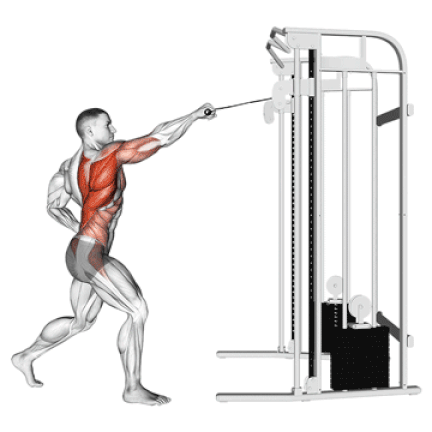
How To Do
- Attach a single grip handle to an elbow-high cable pulley.
- Step back and get into a staggered stance, knees slightly bent.
- Your arm should be out straight, and your waist should be rotated towards the cable.
- Keep your elbow close to your body, and pull back towards your waist while rotating your waist in the same direction.
- Make sure the rotation is in your waist, not your hips. For added stability, you can place your inactive hand on your other hip.
- After a brief pause at the top of the movement, slowly return to the starting position.
13. Cable Twisting Overhead Press
This exercise engages movement in multiple planes simultaneously. The pressing action occurs primarily in the sagittal plane, while the twisting motion activates the transverse plane.
It is brilliant for developing unilateral upper-body strength, improving balance, and strengthening and stabilizing the core.
- The overhead pressing movement trains the shoulder muscles.
- Twisting movement works core muscles—including the obliques and rectus abdominis.
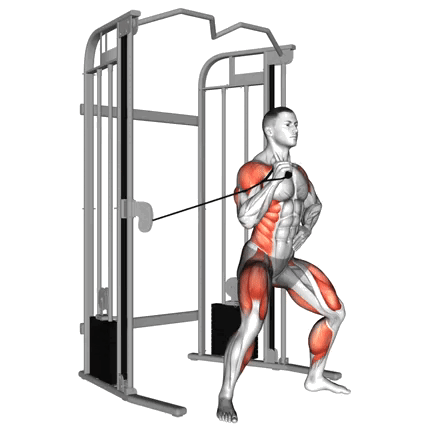
How To Do
- Attach a stirrup (handle) to a low or waist-high pulley. Grasp the stirrup with one hand.
- Spread your legs and squat a little, keeping your torso upright.
- Position the stirrup to the side of your body, with your elbow flexed and tucked into your side.
- Exhale as you straighten your legs, twist your body, and press the stirrup diagonally upward and away from the pulley.
- Hold for a count of two. Inhale as you reverse the motion and return your body and the stirrup to the starting position.
- Complete the desired number of reps with your right arm.
- Repeat the exercise with your opposite arm.
14. Seated Cable Crunch
Seated cable crunches are often preferred by lifters who find the kneeling variation uncomfortable.
While the primary movement is spinal flexion, the core musculature must also work isometrically to stabilize the spine against the cable’s pulling force. This engages deeper core muscles like the transverse abdominis.
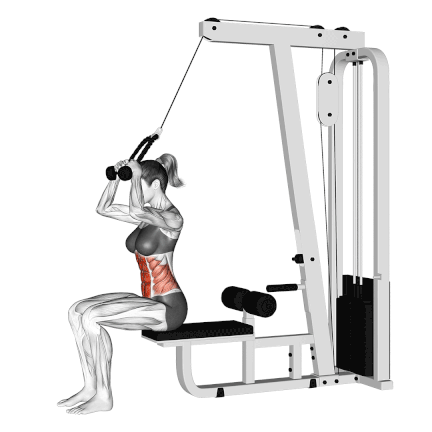
How To Do
- Attach a rope to the high pulley and select an appropriate weight.
- Sit on a flat bench, back facing a high pulley.
- Grasp cable rope attachment.
- While keeping your hips still, perform a crunch with your abs while holding the rope at the backside of your head.
- Engage your core and pull downwards into a crunch, sending your elbows toward your thighs.
- Hold the peak contraction for a moment before returning to the starting position.
- Repeat for the desired number of reps.
15. Cable side crunch on Bosu ball
If you want to get more creative with your cable ab exercises, why not try this exercise?
The cable side crunch on a Bosu ball combines a cable machine’s resistance with the Bosu ball’s instability, which increases the demand on your body’s proprioceptive system.
The primary movement here is lateral flexion of the spine, mainly targeting the obliques (both internal and external).
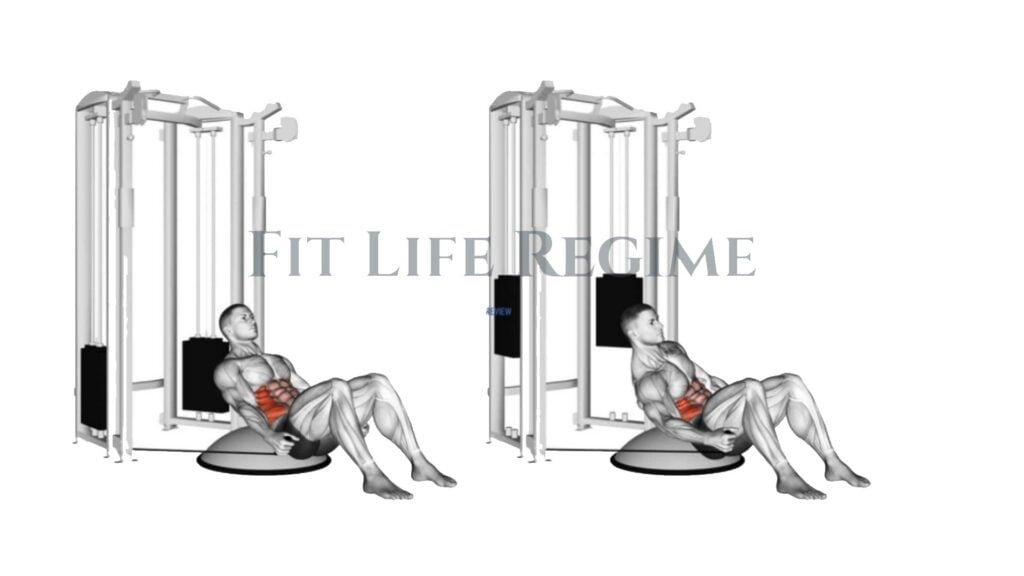
How To Do
- Attach a single-grip handle to both sides on a low setting.
- Using a Bosu Ball, position yourself it in front and center of the machine.
- The small of your back should be arched around the ball. Your butt should be close to the floor but not touching it.
- Both hands should have a cable. Your feet are wide, and your arms are straight in front of you.
- Keep your arms straight. Elevate your torso in a crunching motion without dropping or bending your arms.
- Crunch on one side and then the other until you do the number of reps you want.
Want To Lose Fat? Discover your daily calorie needs with our free TDEE calculator.
Abs and Oblique Cable Workout Routines
Now, you can consider them when planning your workouts. You could use them as a finisher, picking two or three moves and cycling between them with minimal rest in between, or you could train your core separately.
Cable Abs Workout Plan
| Exercise | Sets | Reps |
|---|---|---|
| Kneeling Cable Crunch | 3 | 10-15 |
| Cable Reverse Crunch | 3 | 10-15 |
| Pallof Press | 3 | 8-12 |
| Cable Tuck Reverse Crunch | 2-3 | 8-12 |
| Cable Twisting Overhead Press | 2 | 10-12 |
Cable Oblique Workout Plan
| Exercise | Sets | Reps |
|---|---|---|
| Cable Side Bend | 3 | 10-15 |
| Cable Russian Twist | 3 | 8-10 |
| Cable Wood Chop | 3 | 8-12 |
| Standing Oblique Crunches | 2 | 10-15 |
Cable Core Workout Plan
| Exercise | Sets | Reps/Duration |
|---|---|---|
| Pallof Press | 3 | 10–15 reps |
| Standing Cable Crunch | 1 | 60 seconds |
| Cable Twisting Standing Row | 3 | max reps |
| Cable Twisting Overhead Press | 3 | 8–12 reps |
| Cable Seated Ab Twist | 2 | 10–15 reps |
Of course, you don’t have to do only cable exercises for your ab workouts. You should mix it up with bodyweight core exercises. If you want a well-rounded abs, oblique, and core workout, you must add variation to your workout.
I strongly suggest adding ab rollouts and hanging leg raises to your routine once you have achieved sufficient core strength to perform them safely and correctly.
FAQ
Are cable machines good for abs?
Yes, training your abs with a cable is a good idea. Training abs with cable at the gym helps to build Strong abdominal muscles can help improve posture and balance. They can also help reduce back pain and increase flexibility.
What cable Workout Is Best For Abs?
The cable machine abs exercises mentioned above are a great way to start building six-pack abs if you hit the gym. Choose 3-4 exercises from the list above and do 3-4 sets of each to tone your oblique muscles. Remember, you should never train oblique muscles more than 3 times per week.
How do you lose belly fat on a cable machine?
To lose the extra subcutaneous fat around your waist, lift three times per week, use a weight that makes 8 to 10 repetitions feel hard. You can add variation to your workout by using cables, dumbbells, and barbells. Work up to three sets of each exercise you include in your workout. And also add cardio exercises in your workout regime.
To lose belly fat, you should also limit sugary foods, make 25 to 30 percent of your daily sugar intake, reduce the amount of calories you consume from sugars, and eat healthy fat.
Do cable Abs Workouts Slim Your Waist?
Only a cable abdominal workout will not slim your waist size. Fat does not convert to muscle, so performing abs and oblique cable exercises alone will not result in a reduced waistline.
However, a combination of aerobic exercise and ab cable workouts will most likely yield the most successful results in terms of fat loss and a slimmer waistline.
Takeaways
Combining resistance like cable with free weight exercises produces a better result than training with free weights only in terms of developing power and strength in the upper and lower body. So, combining cable machine abs workout with dumbbell and weight plate ab exercises will accelerate your journey for getting thick and shaped six-pack abs.
Do you have a favorite ab workout that you do using a cable machine? Share it with our readers in the comments section below!
10 Best Abs and Oblique Exercises With Cable Machine

Manish is a NASM-certified fitness and nutrition coach with over 10 years of experience in weight lifting and fat loss fitness coaching. He specializes in gym-based training and has a lot of knowledge about exercise, lifting technique, biomechanics, and more.
Through “Fit Life Regime,” he generously shares the insights he’s gained over a decade in the field. His goal is to equip others with the knowledge to start their own fitness journey.

